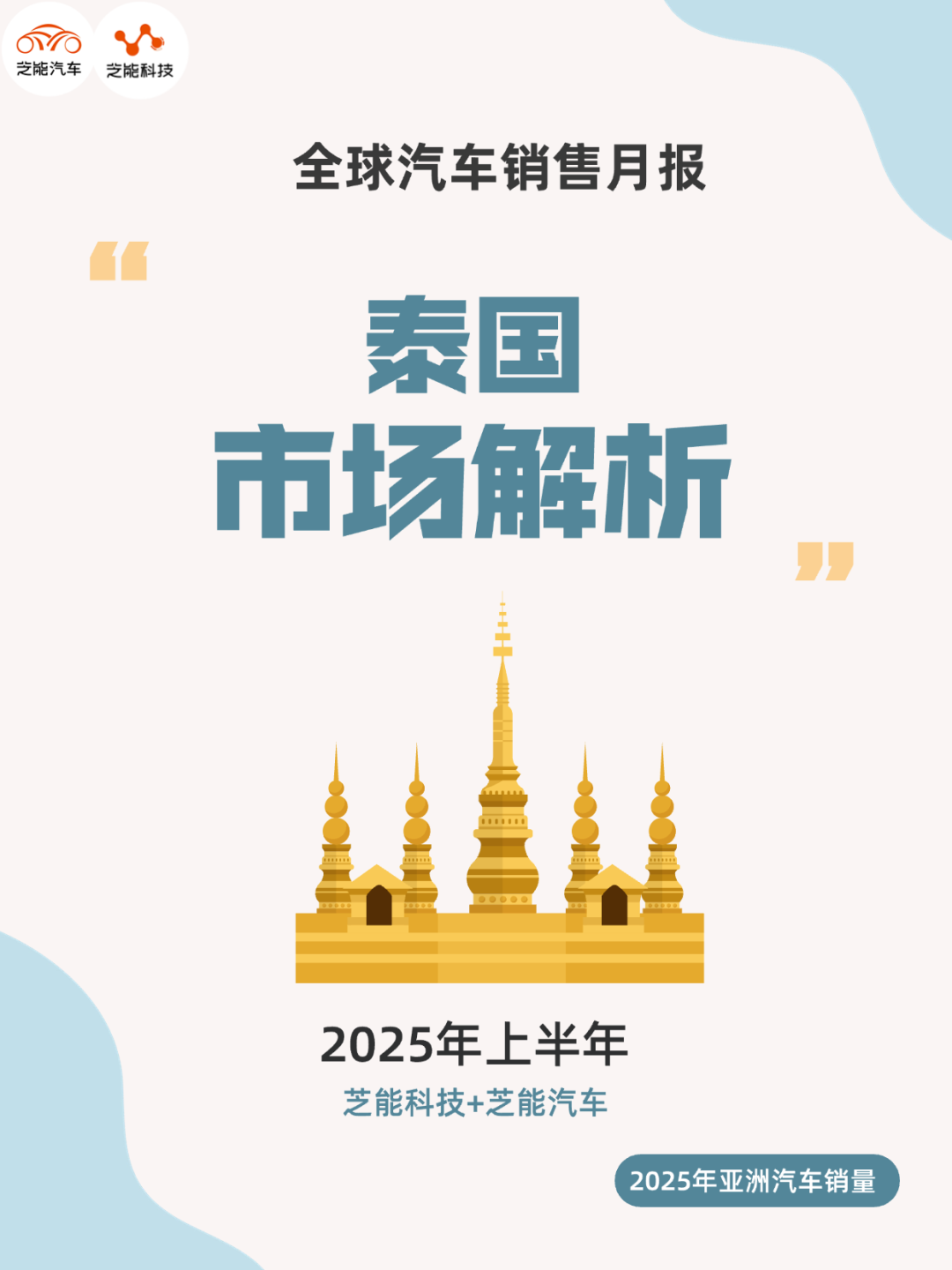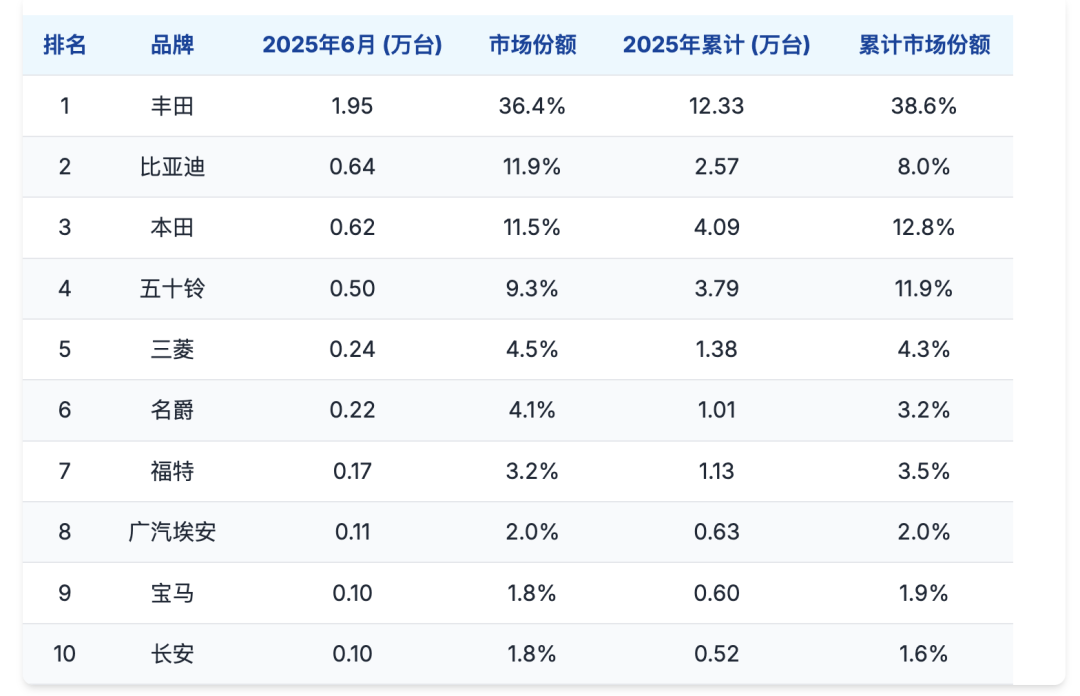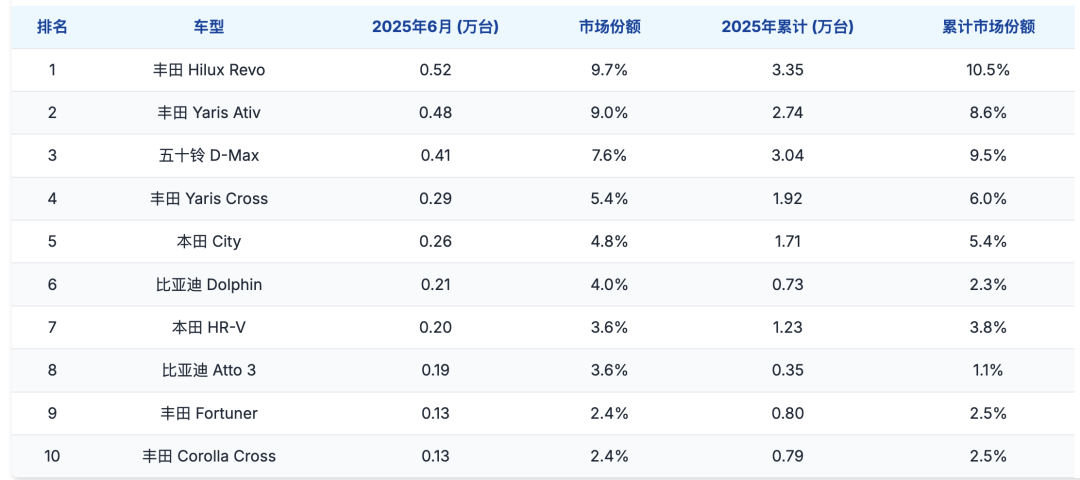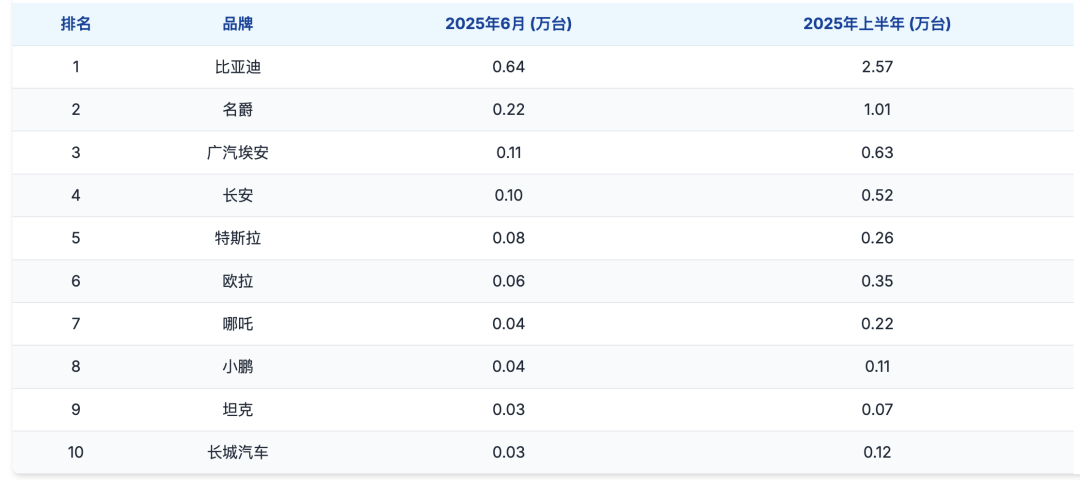Asian Auto Market | Thai Auto Market Undergoes Transformation in the First Half of 2025! Chinese Brands Emerge as Mainstream Players
![]() 08/05 2025
08/05 2025
![]() 477
477

The Thai auto market witnessed a significant shift in the first half of 2025. While the traditional Japanese Big Three continued to lead the charts, Chinese auto brands made substantial strides, moving from the fringes to the mainstream. This transformation began in 2022 when brands like BYD, MG, XPeng, Nezha, and Aion entered the Thai market, initially seen as cost-effective alternatives. By the first half of 2025, however, Chinese companies had emerged as key drivers of the rise in new energy vehicle penetration. Data from the Passenger Car Association and the Thai Automobile Association reveals that Chinese brands' share in the pure electric vehicle segment surpassed 80%, and their share in the overall passenger vehicle market surpassed 15% for the first time.
Sales figures are merely a superficial indicator; the real change lies in the supply structure. In the past six months, Chinese automakers have launched models tailored to Southeast Asian needs, promoted local assembly, expanded sales networks, and accelerated the deployment of charging infrastructure.
From policy adaptation to shifts in consumer perception, Chinese brands have not only enhanced the "usability" of electric vehicles but also gradually increased their "desirability".
01 Thai Auto Market: Traditional Fuel Vehicles Gradually Lose Dominance
In June 2025, total new vehicle sales in Thailand rebounded to 53,500 units from the previous month. Cumulative sales for the first half of 2025 reached 319,600 units, gradually stabilizing amidst a low base and policy support.
Brand share insights:
◎ Toyota remains atop with a 36.4% market share, but this has declined slightly from 38.6% in the same period last year, as its share is eroded by rapidly rising new energy brands.
◎ BYD sold 6,380 units in June, capturing a 11.9% market share, overtaking Honda (6,183 units, 11.5%) to become the second largest brand in the Thai market.
◎ Isuzu ranks fourth with 4,998 units (9.3%).
◎ Mitsubishi (4.5%), MG (4.1%), Ford (3.2%), and other Japanese and joint venture brands follow closely.
◎ GAC Aion and Changan also debuted in the top ten, showcasing the collective advancement of Chinese brands in the Thai market.

From a model perspective, pickup trucks and compact cars remain the preferred choices of Thai consumers.
◎ The sales champion is still the Toyota Hilux Revo with 5,170 units.
◎ Followed by the Yaris Ativ (4,814 units) and Isuzu D-Max (4,073 units).
◎ Among new energy models, BYD Dolphin ranks sixth with 2,141 units, while Atto 3 and Sea Lion 7 also feature in the top ten and top fifteen, respectively, indicating that electric vehicles have already garnered a significant consumer base in the Thai market.

From a powertrain perspective, while hybrid and pure fuel models still dominate the market, the penetration rate of pure electric vehicles is surging.
In June 2025's top 20 best-selling models, multiple electric vehicles such as BYD Dolphin, Atto 3, MG4, Sea Lion 7, Tesla Model Y, and Ora Good Cat made the list, signifying a substantial improvement in the Thai market's acceptance of electric vehicles.
The Thai auto market stands at a pivotal juncture where fuel and electric vehicles coexist, and traditional brands fiercely compete with new players. The increasing penetration of Chinese brands represents the most influential variable.
02 Collective Effort by Chinese Brands: BYD Leads, New Energy Accelerates Breakthrough
Chinese brands shone brightly in the Thai market in June 2025. Among them, BYD, GAC Aion, Changan, MG, Ora, XPeng, Geely, Denza, Zero Run, Nezha, Zeekr, and Great Wall achieved varying degrees of sales growth, with an overall market share nearing 30%.
◎ BYD stands unchallenged as the leader. It sold a total of 6,380 units in the Thai market in June, occupying a 11.9% market share, with significant month-on-month and year-on-year increases.
Its flagship model, Dolphin, sold 2,141 units in a single month, jumping to sixth place; Atto 3 sold 1,941 units, ranking eighth, with a notable month-on-month increase; Sea Lion 7 and Sea Lion 6 also featured in the top 20 with 1,124 and 743 units, respectively.
BYD is establishing a robust product lineup in the Thai market, encompassing small cars, compact SUVs, and mid-size SUVs, thereby broadening its target audience.

◎ MG4 ranks eleventh with sales of 1,211 units.
◎ Ora Good Cat ranks 25th with sales of 517 units, maintaining a visible presence on the list.
◎ GAC Aion's Y Plus, V, and Hyper HT models combined for sales of 1,063 units.
◎ Changan sold 866 units with its Tibba S07 and Tibba L07 models.
◎ Denza D9 ranks 42nd with 246 units, becoming one of the few new energy models in the mid-to-high-end MPV segment to feature on the list.
◎ XPeng X9 and G6 sold 198 and 165 units, respectively, rapidly building local user awareness.
Beyond pure electric vehicles, the expansion of hybrid products is also underway. For instance, BYD Sea Lion 6 DM-i sold 743 units in June, occupying a preferred position among multi-scenario users in the new energy market, reflecting the local adaptability of its "electric + hybrid" dual-track strategy.
From a competitive standpoint, Chinese brands have established a significant scale effect in the Thai market by leveraging a comprehensive new energy product portfolio, favorable price-to-performance ratios, and continuous local channel development.
Particularly, BYD, through SKD assembly, channel expansion, and localized marketing, swiftly transitioned from a "reserve brand" to a "mainstream option". Other brands such as GAC Aion, Changan, Ora, and XPeng have begun to tap into different market segments with model diversity and differentiated designs, collectively bolstering the overall image of Chinese brands.
Summary
The rise of Chinese brands in Thailand is not merely driven by low prices or subsidies. What truly shapes the outcome in the first half is product strength and response speed. Chinese automakers boast faster product cycles and updates, enabling them to better meet consumers' actual needs.
The first half of 2025 marked a crucial period for Chinese automakers to achieve a "qualitative leap from quantitative growth" in Thailand. Japanese brands still possess a solid user base and channel system, particularly in the pickup truck and B-segment car markets, where Chinese brands have yet to truly penetrate.





